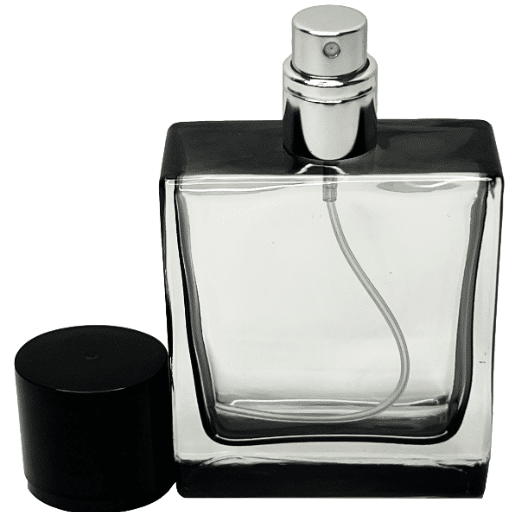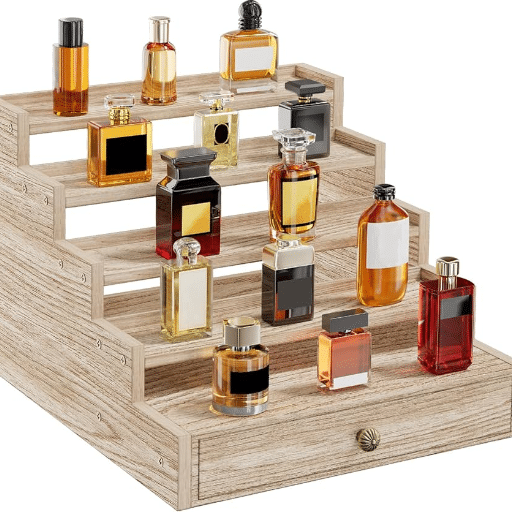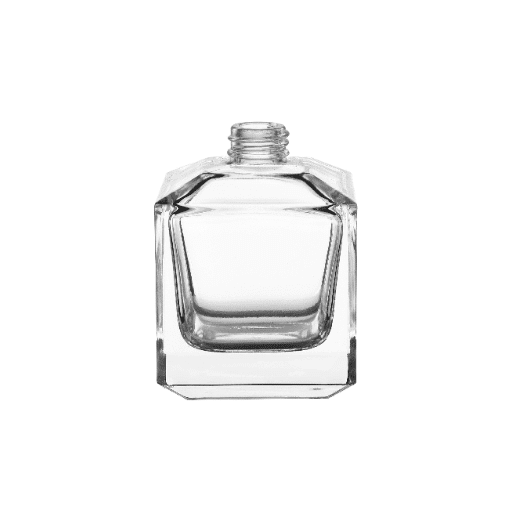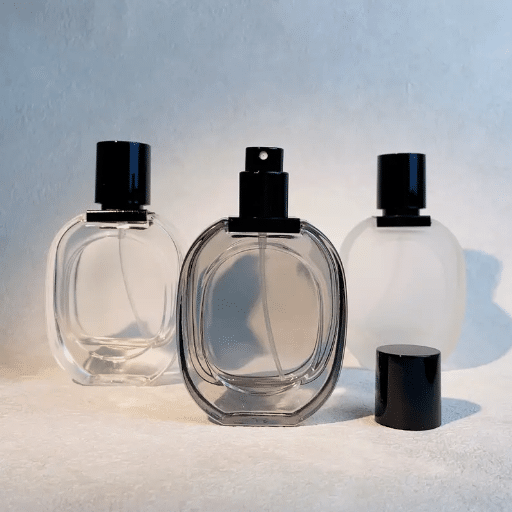They are the very epitome of opulence—perfume bottles are no mere containers; they are intricate pieces of art designed to fuse form, utility, and state-of-the-art technology. Every single part of the perfume bottle, from the most elegant cap to the most exquisite atomizer, has its purpose and plays a part in carrying and making the most of the scent in general. This article will guide you through the exploration of how a perfume bottle is created and elaborate on every part of it, including the people who made it and why they chose to add the details. Whether it is a delight in the scent and its many words or enumerated by the artistic and creative features of the everyday, it is hoped that the presentation of the qualities and purpose of perfume bottles has gone quite smoothly.
Introduction to Perfume Bottles
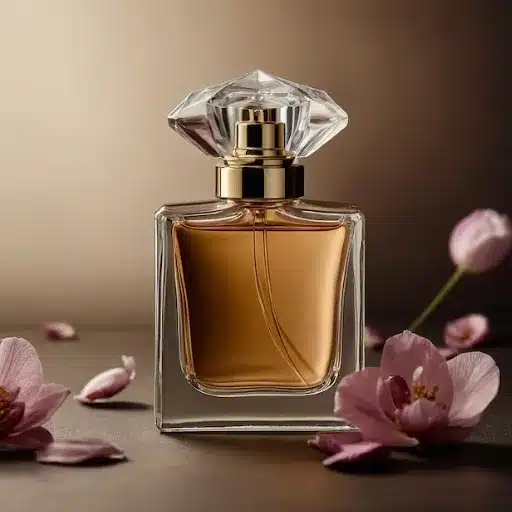
When a fragrance needs to be concentrated and there is no splash about floor covering, then perfume bottles are certainly the best tools for that. For the most part, these vessels come in the form of glass or other efficient plastics that are capable of preserving the fragrance undisrupted by any external elements such as sunlight or dust. Design of the package; shape and colour design of the bottle; decoration of the bottle, usually is the decoration of the perfume, no less than its content words; however, the figures at the same time remain the figures. However, spray nozzles interfere where proper controls and pipelines are required and airtight closures are demanded.
Overview of Perfume and Its Importance
A fragrance is far more than a resilient smell; it incorporates creativity and history with the application of science. Oil- or alcohol-based, nearly every fragrance is an elaborate creation that is carefully crafted. This chemical mixture is also known as fragrance. That undergoes a meticulous process of formulation to produce each fragrance within the perfect harmony of scents. It is generally classified into three notes, top, middle, and base, which all contribute to the olfactory experience in a unique way. The top notes leave the first impression, the middle notes are the heart of the fragrance, and the base notes add the dimension and durability. Not only does this method improve the way the person smells, looks at, touches, and enjoys the product, but it also means practicability due to the amount of training and background necessary for any such product.
With no doubt, the world importance of perfumes goes far beyond its appeal to the senses. It is worth noting that in the past, fragrance was used to create an impression of and also encourage a good life for whoever applies it. Scent research suggests that positive olfactory emotions help relax a person, increase sociability and a sense of security, and contribute to achieving the desired effect. As technology advances, the consumption of fragrant goods also increases with the growing dynamism in various value chains. Therefore, it is clear that the ideas and practices of perfumery with which people are familiar and that they appreciate have undergone some alterations that are more acceptable given the current circumstances.
What Constitutes a Perfume Bottle?
It’s not just a round bottle designed to contain essential oils, but rather an architectural marvel that represents a sumptuous combination of design, function, and visual appeal. A quintessential package design for perfume usually consists of a glass or plastic container bearing a cap—a central part of any dome—and an atomizer. These modern-day domes often feature intricate renderings that incorporate elements such as crystal, frosted or clear glass, and metal to convey a sense of sophistication. The build and appearance of the bottling are also tailored to take into account what the senses may want to project or convey. Moreover, it has been observed that new trends have enabled the use of biodegradable bottles and refillable container varieties, which have significantly contributed to bridging the eco-conscious product preference gap. This combination of artistry, functionality, and environmental friendliness becomes even more important since it articulates the way in which perfume bottles change over time in modern societies.
Significance of Bottle Design in Fragrance
It is not just the scent inside that a designer can present in an object, but also the object itself, as a soap in a fashion context is usually not a wonder. Nevertheless, the latter is somewhat opposite to the former because it is difficult to shape a good smell, whether as a behavior modification has a place in some people’s reality, effectively or appropriately. Some studies have demonstrated that the shift in the appearance of the package helps to make the product in question more saleable. This means that phrases like ‘less is more’ will be associated with certain design schemes, while over-generous design will be equated to an expenditure of some additional money. Additionally, other customers may require special types, such as recycling or refillable perfume bottles, which are produced from environmentally friendly materials, due to shifts in trends. The perfect appearance, coupled with the ease of identifying and using the product, makes the bottle design in perfumery a matter of great concern.
Main Components of a Perfume Bottle
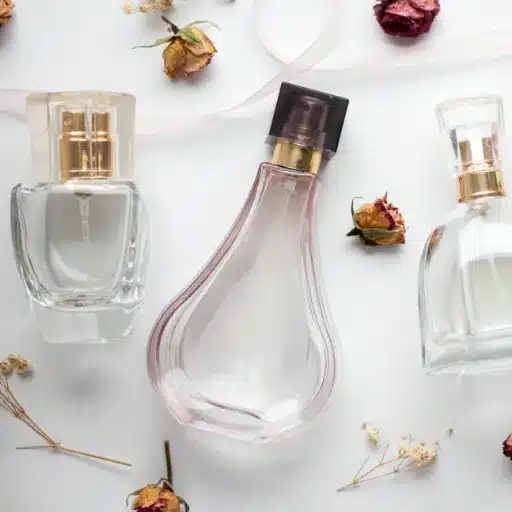
The major components of a perfume bottle are as follows:
- Bottle Body – This is the main slim container that holds the scented liquid, usually made of glass or one of the suitable high-quality plastics – it is built to prevent spillage and evaporation.
- Cap – This component is the top cover that, if removed, makes the perfume bottle compliant with the travel requirements as it stays sealed in the container even when stored in an upright position.
- Nozzle or Atomizer – This is the part of the bottle that releases the scent. It is used to provide an even distribution of the scent.
- Tube – This is a small, extendable tube attached inside the nozzle, which assists in drawing the liquid contents from the bottle.
Each part has its own importance in how it functions in addition to its aesthetic appeal in the context of the whole activity or experience, which leads a person to use it better developed.
Body of the Bottle: Shape and Material
The “body” of the bottle serves two functions: it protects the fragrance and enhances the aesthetic aspect of the fragrance’s design. Scent bottles range from humble and plain to extravagant and elaborate modern works, depending on the visual form of the container itself. These examples were created to represent the brand and reflect the theme of the fragrance. Glass is the primary material used in making perfume bottles, as many perfume brands prefer this type for its properties and preservation, which include strength, transparency, and scent perception. Other bottles are made from painted, frosted, or striated glass, adding an extra feature to the bottle design. Additionally, in achieving the intended design concept, some of these containers are augmented with high-quality plastics and metals, which also enhance their functional aspects and durability, as well as their portability characteristics. This means that there is both the ‘how shall it work’ concept and the ‘what shall it look like’ concept, which makes the perfume a valid part of the overall product experience, including the package design.
Neck and Collar of Perfume Bottles
Different aspects of a perfume bottle can enhance its appearance or functionality, such as the Neck and collar. Overall, the neck is designed to connect to the closure system effectively, thereby providing a tight, leak-proof seal that conserves the substance against deterioration. In situations when the perfume is to be sent somewhere or when it is being used in daily situations, reinforcements are often designed in such a manner as not to go out of shape and avoid the escape of smells from the bottle in case the primary material cannot curve under the pressure. Mostly, the collar of the bottle lacks these facilities but includes quality aspects, such as different artistic accompaniments, including metallic linings or special copper coverings, or even an area with embossed engravings or branding. All these enable more than just bringing back the aesthetics of the packaging to the user; they help to highlight the company’s image, thereby making the perfume bottles more exclusive and unique for marketing purposes.
Understanding the Nozzle and Atomizer
The nozzle and the sprayer are integral parts of a perfume bottle, designed to produce a fine and uniform fragrance mist. The sprayer works by loading liquid perfume particles with air pressure and dividing them into smaller fragments, which in turn creates a uniform spray that allows the scent to be more easily spread in the air. Sprayers of the present time are made with enhanced modern technology that sprays smoothly and with minimal force, in most instances having dials for mist level adjustment, allowing for a one-of-a-kind spritz. Atomizers, which are designed for guns and smoke, are made in such a way that they do not clog easily, hence they tend to be longer-lasting and work consistently well. This simplicity of these steps not only enhances usability but helps to place the fragrance more n the luxury side thus enhancing the functionality of the product.
Perfume Bottle Caps: Aesthetic and Functionality
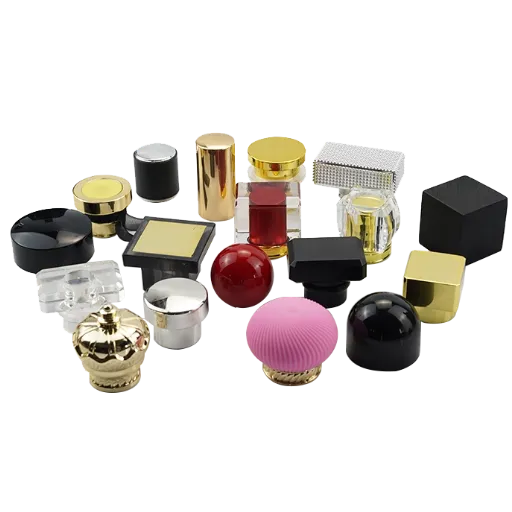
The caps of perfume bottles have two sides. There is an artistic cap that enhances the bottle’s appearance and marketing appeal. Such caps are known for exhibiting the brand arts and opulence. They are known for this purpose, or they serve that purpose. First of all, they are used to this extent. Secondly, these covers fit tightly around any container, and in this case, a container with a liquid fragrance. They protect the fragrance by preventing it from leaking and also from spoiling over time. The caps manufactured from high-grade raw materials and having unique designs are resistant to wear and tear, and their efficiency meets the requirements of the applied cosmetics box designs.
Types of Perfume Bottle Caps
| Type | Description | Material Used | Purpose/Feature |
|---|---|---|---|
| Screw Caps | Threaded design for secure closure | Metal, Plastic | Prevents leaks, easy to use |
| Magnetic Caps | Uses magnets for a snug fit | Metal, Plastic, Magnet | Elegant, effortless closure |
| Snap-on Caps | Press-to-fit design | Plastic, Metal | Quick to apply and remove |
| Wooden Caps | Eco-friendly and natural material | Wood | Adds rustic, sustainable appeal |
| Crystal/Glass Caps | Made from transparent or decorative glass | Glass, Crystal | Enhances luxury and visual elegance |
| Metal Caps | Polished and durable metal finishes | Aluminum, Steel | Offers premium and durable aesthetic |
| Resin Caps | Molded synthetic polymer design | Resin | Versatile, customizable, and unique |
| Alloy Caps | Combines metals for strength and style | Metal Alloys | Balances robustness and sophistication |
| Ceramic Caps | Crafted from high-quality ceramics | Ceramic | Transmits luxury and artistic appeal |
| Decorative Caps | Designed with intricate patterns or embellishments | Various (Metal, Crystal) | Highlights artistic and brand identity |
Role of the Cap in Preserving Fragrance
One of the most crucial parts of a perfume bottle can hardly be doubted, since it is that which guarantees the persistence and the quality of the fragrance contained. A breach of that case is that in sealing the bottle, which works to impede the contact of the perfume contents with air, minimizing oxidation exposure. Oxidation is the change in a fragrance’s chemical properties, which may result in a loss of the fragrance’s scent efficacy over time. Moreover, the city also safeguards the smell from external surroundings, such as light and moisture, which can significantly disrupt the stability of aromatic compounds. These days, chemical and scientific engineers have improved the sealing of the caps; this way, the chance of maintaining the scent in optimal condition even after a long period of time is possible. Caps and perfumes are the same. But caps and perfumes, when coated with dust, should be cured.
Innovative Designs in Perfume Bottle Caps
Progress has indeed breathed new and intricate craft into that part of the perfume bottle that is just a simple cosmetic cap. Convenient locking system taps are widespread these days – they are really convenient and social. At the same time, there is a trend to increase the use of recycled materials, such as bamboo and light metals, in the design of these caps, which form bio-friendly packaging. Moreover, manufacturers are increasingly introducing concepts of interactivity, for example, by including radio frequency chips in their caps, making it easy to download digital tools that provide additional services in retail, such as an app for product authentication or even offering customers tips on which fragrance to use. Such state-of-the-art concepts primarily focus on the proper containment and preservation of the juice, while also accommodating the current needs of sustainability and utility within a given framework, and without any expediency, almost become the sole means of art in today’s perfumery-making.
Exploring Luxury Perfume Bottles
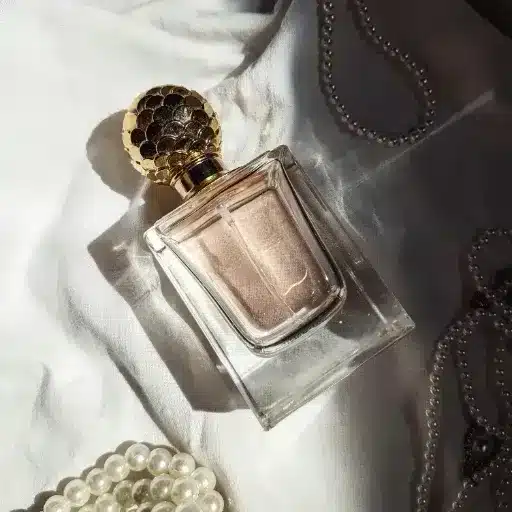
In the context of luxury perfumes, nothing is more appealing than adjusting the fragrance’s design. This often produces the most satisfying levels of completion, featuring durable materials such as glass or crystal, elaborate accents, and shapes that express the character of the brand. These containers not only keep the perfume itself safe but also provide a fashion that represents a well-to-do and sophisticated outlook. Additionally, the aesthetic aspect contributes to the high regard for and rarity of such luxury perfume bottles among many people, as they are already recognized as an art form.
Characteristics of Luxury Perfume Bottles
- Premium Materials – There are such luxury perfume bottles in imaginary materials: Plastic and stainless steel, but more commonly, they are made from crystal, hard, heavy, thick glass, and sometimes boosted with decorations in metals ranging from silver to gold, connecting it not only with economy, but also with social class.
- Artistic Designs – Most luxury models also claim to follow artistic considerations, for example, because they may offer highly decorated or aesthetically pleasing, sometimes even outrageous, modern persons. Some of these designs also show the inspiration of the perfume or the brand.
- Handcrafted Elements – Some high-end perfumery regularly utilizes manual labor, featuring several bottles that showcase craftsmanship by artisans. This includes careful attention to details, such as hand-placed embellishments, carvings, and often includes engravings of logos.
- Unique Closures – In the case of luxury fragrances, the refuse caps come in various styles and are often decorated. Such covers may have painted decorations, some made of metals, or the shape may be peculiar to particular scents.
- Limited Editions – A large percentage of luxurious fragrances come in limited editions. If so, these typically have serial codes and or are authentic collectors’ items.
- Sustainability Features – The environmental benefits of luxury operating systems, which incorporate eco-friendly aspects, including the use of recyclable materials and products that can be easily recycled, will eventually become the norm.
Unique Design Elements in Luxury Bottles
Showcases the true essence of luxurious wine bottles with a big heart hidden behind a high stance. They do the job of preserving the wine and perform other supportive services. Esthetics is emphasised in all the details, from bylines and clutches to cloak mounts. Such aggressive possessions come with high-end details, such as intricate carvings, 3D elevations, or one-of-a-kind closures, which automatically attract the attention of the focus. Along with these claims, other shapes, such as vertically stretched forms or those inspired by the structures of a building, can also be observed. This text explains that designers take unusual risks with shape simply because they can, pushing the bounds of what a design, which is traditionally characteristic of a product, can be, even with the increasing emphasis on these extravagant elements, which include metallization and special coatings. Because of their surfaces, these designs can sometimes be quite good in the antireflection department. For example, it is possible to include company writing and initials, due to the name or the needs of the word. It is generally understandable that all details above not only make the visual interpretation of the subject complete but also help the new bottle stand out as a priceless artefact which any luxury vehicle fan would inscribe in their hearts.
Types of Luxury Perfume Bottles and Their Appeal
| Type of Bottle | Key Features | Appeal |
|---|---|---|
| Crystal Bottles | Made from fine crystal, intricate craftsmanship | Exudes luxury and timeless elegance |
| Hand-Blown Glass Bottles | Unique shapes, artistic designs | Ideal for collectors and art enthusiasts |
| Gilded Bottles | Adorned with gold or precious metals | Symbolizes opulence and grandeur |
| Minimalist Bottles | Sleek, modern designs with clean lines | Appeals to contemporary aesthetics |
| Vintage-Inspired Bottles | Retro details, reminiscent of classic eras | Nostalgic charm, historical allure |
| Jewel-Encrusted Bottles | Embellished with gemstones or crystals | Radiates extravagance and exclusivity |
| Customizable Bottles | Option for engraving or bespoke designs | Personal and one-of-a-kind keepsakes |
| Refillable Bottles | Eco-friendly, durable material | Sustainable, practical for long-term use |
| Thematic Bottles | Designed to represent specific themes or stories | Distinctive and emotionally engaging |
| Limited Edition Bottles | Produced in small quantities, rare designs | Highly coveted by collectors and fans |
Perfume Packaging: Beyond the Bottle
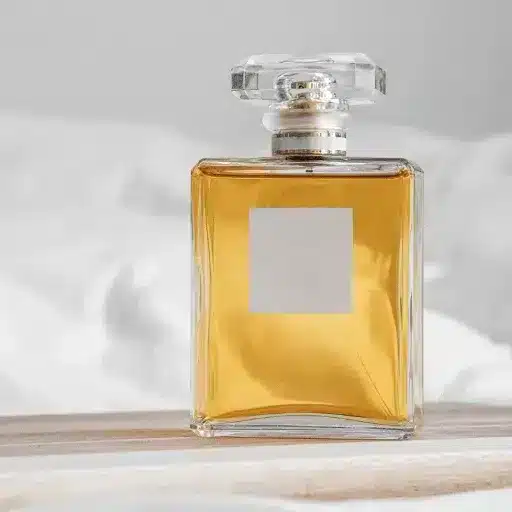
When it comes to perfumes, people may love or hate the fragrance because of the packaging. Apart from just containing a bottle of fragrance, the packaging is expected to incorporate the brand’s image, evoke an emotional response in the buyer, and attract attention when displayed on the shelves. Aspects such as sustainability, complex textures, and new functions like refillable packaging all work to enhance the appeal and desirability of the packaging for the perfume. Finally, well-created packages and presentations incorporating scents end up elevating the use of an ordinary product into an unforgettable experience that captivates the mind.
Impact of Packaging on User Experience
When it comes to user experience, packaging is at the forefront as it is actually the first tangible and visual contact one has with a product. An original package can greatly impact the consumer decision and quality of the product, enhancing the brand beyond the single purchase. There has been an increase in the use of so-called environ-logistics, with many individuals preferring green designs over aesthetically pleasing ones. Additionally, it appeared that the user was able to utilize the products to their fullest potential, with some expressing their appreciation for features such as easy-open containers and resealable packaging. Believe it or not, someone’s introduction didn’t last more than 20 seconds. The other person took over the topic of the revolution and the people’s power to overthrow tyrants. The use of SEO and paid advertising is two forms of supporting a search engine marketing campaign.
Materials Used in Perfume Packaging
The diversity of materials used in perfume packaging is extensive, with each chosen for its suitability to the project at hand. Glass is a very popular choice, as it is not susceptible to moisture, thereby preserving the fragrance of the product. The packaging can give a more delicate yet upscale appearance. It’s also common for environmentally friendly glass types, and more so for recycled glass, as it aligns with the idea that many companies, if not most of them, have adopted more eco-friendly practices and measures. Additionally, when considering environmental impacts, plastic is one of the most popular alternatives, despite being the only commodity that can withstand all hardships. Unlike conventional plastic, innovative and environmentally friendly materials, such as biodegradable plastic or PCR (post-consumer recycled) plastic, are often considered.
Materials such as aluminum and stainless steel are commonly used in caps, sprayers, and other products, which give them toughness, efficiency, and a nice appearance as well. They are combined with paper and cardboard used for outer boxes, which are typically produced from FSC or recycled fibers, to minimize environmental impact. There are niche brands that are trying their hand at different materials, like ceramics, to give that artisanal feel. Finding the balance between serving the purposes of perfume packaging and pleasing the hearts of customers, the offer becomes richer with each table, traditional and innovative, reflecting the character of a conscious consumer who is environmentally respectful and stylish.
Trends in Perfume Packaging Design
The trends in the text are, to a great extent, attuned to consumer tastes; they are quite modern and differ significantly from previous marketing strategies. The new product, a packaging solution for perfume, is very contemporary; it is likely to be packaged in a sleek, slim cylinder that allows the contents to be visible. User-friendly options become essential, such as the ability to personalize the packaging with eye-catching messages and/or words. Niche markets with accessories, featuring the exclusive, tasteful design that has been adopted, have become highly prevalent today.
It is noteworthy to mention that another significant influence in the perfume industry is the introduction of modern technologies, such as advanced product packaging that is linked to smartphones and capable of providing infomercials on the product under discussion or recommending other products with similar fragrance notes. Equally well, eco-friendly practices are developing fast. With the growing number of people clamoring for sustainable solutions, manufacturers have resorted to introducing consumable-once refillable containers and introducing biomatter and marine polymer.
Furthermore, companies are exploring various, original bottle shapes that are both traditional and interesting, making them unforgettable. The idea of having a bottle that resembles a certain shape or substance, such as a sculpture or a natural form, resonates more with the consumer, and the product becomes an artifact in itself. For this reason, it can be said that these are recent design trends that signal a phase in which design innovation and sustainability have interacted and reshaped the fragrance industry.
Reference Sources
-
Construction of perfume bottle visual design model based on multiple affective responses
- Summary: This study focuses on creating a visual design model for perfume bottles by analyzing multiple affective responses. It involves breaking down perfume bottle designs into elements and features based on the experiences of five designers.
-
Potential dimensions of consumers’ affective responses to perfume bottle form
- Summary: This paper explores the psychological and emotional responses of consumers to the form of perfume bottles. It identifies key factors that shape consumer perceptions and preferences.
Frequently Asked Questions (FAQs)
Q: What Are the Main Components of a Perfume Bottle?
A: One of the most significant aspects of developing a perfume bottle is recognizing its parts. The included parts must conform and must be connected in a way that allows a perfume to be usable and preserved, or the technology is merely irrelevant. Probably one of the first parts identified according to the major bottle components is the bottle itself, such a recipient, made from glass or plastic to facilitate introduction of fragrance into the bottle and some material may be poured on top with that of the neck and the collar. The neck and collar support the cradle that holds the cap, providing a tighter fit and preventing leakage.
Q: How Does the Design of a Perfume Bottle Impact User Experience?
A: The design of a fragrance bottle impacts the user experience as it is, in effect, an aid to how easily the fragrance can be applied and felt in the hand. A well-designed bottle will have a comfortable shape that fits nicely in the palm, making perfume application easier. The nozzle type also influences the application of fragrance in the perfume bottle and its overall impression, either positively or negatively. Sleek perfume bottles are not only designed in medium shapes, but special dimensions and decorative features are added to ensure excellent user satisfaction. Additionally, perfume bottles made of high-quality materials not only last for numerous hours but also serve their purpose effectively.
Q: What Is the Role of the Bottle in Preserving the Fragrance?
A: The significance of the container in terms of preserving the smell is immeasurable since it keeps the aftereffects away from direct light, everything that could affect it, or lighting conditions. Superior quality perfumes typically come in bottles designed to minimize ventilation, such as those with a highly colored or opaque finish, which prevents the entry of any light except for the essential rays. This includes, in addition, how the perfume bottle is covered, whether by using a screw cap or an atomizer, and this factor is very crucial for the content of the perfume. Storage of the perfume in the right bottle can significantly extend the life of the fragrance, allowing it to retain its original scent.
Q: What Are the Different Types of Perfume Bottle Caps?
A: There are a lot of cap models that differ from each other by type: screw cap, spray, flap, etc. And every such cap plays its part and can largely influence the use. For instance, an atomizer features a fine mist application, making it easy to apply the perfume without wasting any. Also, other components, such as a stopper, can help to conserve the dressing, and it is usually called a screw cap. In addition, the device also baby on the aesthetic aspect of the bottle, some intricate designs include decorative caps. The use of the appropriate cap, besides being mandatory for the proper operation, is also an internal component of the bottle’s attractiveness.

